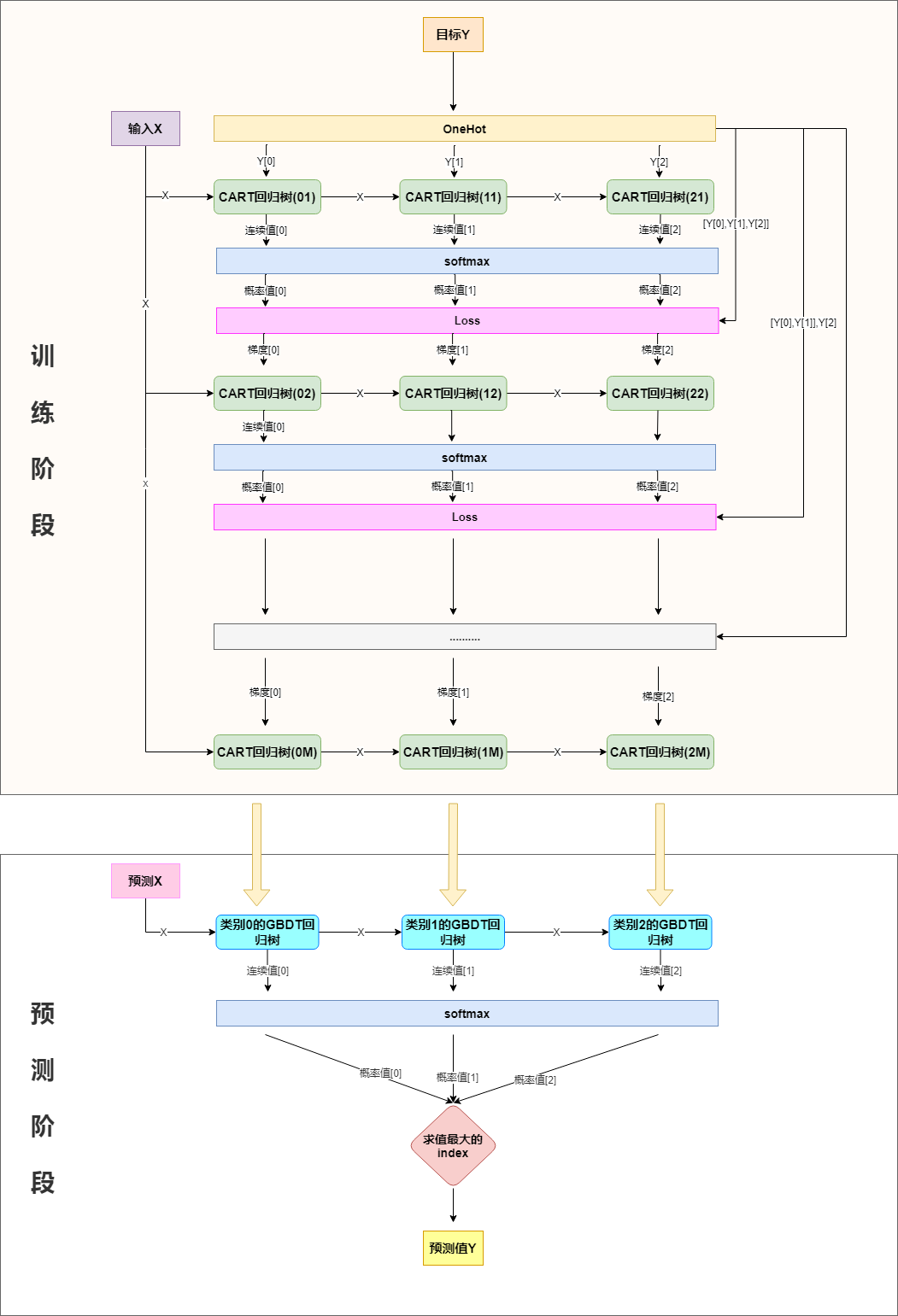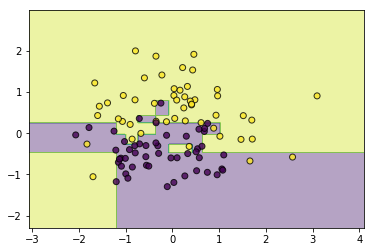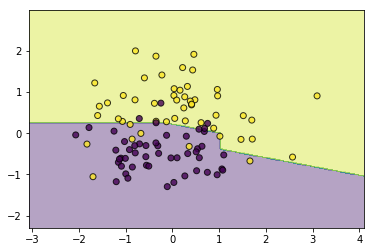《机器学习Python实现_10_06_集成学习_boosting_gbdt分类实现》
一.利用回归树实现分类
分类也可以用回归树来做,简单说来就是训练与类别数相同的几组回归树,每一组代表一个类别,然后对所有组的输出进行softmax操作将其转换为概率分布,然后再通过交叉熵或者KL一类的损失函数求每颗树相应的负梯度,指导下一轮的训练,以三分类为例,流程如下:

二.softmax+交叉熵损失,及其梯度求解
分类问题,一般会选择用交叉熵作为损失函数,下面对softmax+交叉熵损失函数的梯度做推导:
softmax函数在最大熵那一节已有使用,再回顾一下:
\]
交叉熵在logistic回归有介绍:
\]
将\(p_i\)替换为\(\frac{e^{y_i^{hat}}}{\sum_{i=1}^n e^{y_i^{hat}}}\)即是我们的损失函数:
=-\sum_{i=1}^n y_i(y_i^{hat}-log\sum_{j=1}^n e^{y_j^{hat}})\\
=log\sum_{i=1}^n e^{y_i^{hat}}-\sum_{i=1}^ny_iy_i^{hat}(由于是onehot展开,所以\sum_{i=1}^n y_i=1)
\]
计算梯度:
\]
所以,第一组回归树的拟合目标为\(y_1-\frac{e^{y_1^{hat}}}{\sum_{i=1}^n e^{y_i^{hat}}}\),第二组回归树学习的拟合目标为\(y_2-\frac{e^{y_2^{hat}}}{\sum_{i=1}^n e^{y_i^{hat}}}\),....,第\(n\)组回归树的拟合目标为\(y_n-\frac{e^{y_n^{hat}}}{\sum_{i=1}^n e^{y_i^{hat}}}\)
三.代码实现
import os
os.chdir('../')
from ml_models.tree import CARTRegressor
from ml_models import utils
import copy
import numpy as np
import matplotlib.pyplot as plt
%matplotlib inline
class GradientBoostingClassifier(object):
def __init__(self, base_estimator=None, n_estimators=10, learning_rate=1.0):
"""
:param base_estimator: 基学习器,允许异质;异质的情况下使用列表传入比如[estimator1,estimator2,...,estimator10],这时n_estimators会失效;
同质的情况,单个estimator会被copy成n_estimators份
:param n_estimators: 基学习器迭代数量
:param learning_rate: 学习率,降低后续基学习器的权重,避免过拟合
"""
self.base_estimator = base_estimator
self.n_estimators = n_estimators
self.learning_rate = learning_rate
if self.base_estimator is None:
# 默认使用决策树桩
self.base_estimator = CARTRegressor(max_depth=2)
# 同质分类器
if type(base_estimator) != list:
estimator = self.base_estimator
self.base_estimator = [copy.deepcopy(estimator) for _ in range(0, self.n_estimators)]
# 异质分类器
else:
self.n_estimators = len(self.base_estimator)
# 扩展class_num组分类器
self.expand_base_estimators = []
def fit(self, x, y):
# 将y转one-hot编码
class_num = np.amax(y) + 1
y_cate = np.zeros(shape=(len(y), class_num))
y_cate[np.arange(len(y)), y] = 1
# 扩展分类器
self.expand_base_estimators = [copy.deepcopy(self.base_estimator) for _ in range(class_num)]
# 拟合第一个模型
y_pred_score_ = []
# TODO:并行优化
for class_index in range(0, class_num):
self.expand_base_estimators[class_index][0].fit(x, y_cate[:, class_index])
y_pred_score_.append(self.expand_base_estimators[class_index][0].predict(x))
y_pred_score_ = np.c_[y_pred_score_].T
# 计算负梯度
new_y = y_cate - utils.softmax(y_pred_score_)
# 训练后续模型
for index in range(1, self.n_estimators):
y_pred_score = []
for class_index in range(0, class_num):
self.expand_base_estimators[class_index][index].fit(x, new_y[:, class_index])
y_pred_score.append(self.expand_base_estimators[class_index][index].predict(x))
y_pred_score_ += np.c_[y_pred_score].T * self.learning_rate
new_y = y_cate - utils.softmax(y_pred_score_)
def predict_proba(self, x):
# TODO:并行优化
y_pred_score = []
for class_index in range(0, len(self.expand_base_estimators)):
estimator_of_index = self.expand_base_estimators[class_index]
y_pred_score.append(
np.sum(
[estimator_of_index[0].predict(x)] +
[self.learning_rate * estimator_of_index[i].predict(x) for i in
range(1, self.n_estimators - 1)] +
[estimator_of_index[self.n_estimators - 1].predict(x)]
, axis=0)
)
return utils.softmax(np.c_[y_pred_score].T)
def predict(self, x):
return np.argmax(self.predict_proba(x), axis=1)
#造伪数据
from sklearn.datasets import make_classification
data, target = make_classification(n_samples=100, n_features=2, n_classes=2, n_informative=1, n_redundant=0,
n_repeated=0, n_clusters_per_class=1, class_sep=.5,random_state=21)
# 同质
classifier = GradientBoostingClassifier(base_estimator=CARTRegressor(),n_estimators=10)
classifier.fit(data, target)
utils.plot_decision_function(data, target, classifier)

#异质
from ml_models.linear_model import LinearRegression
classifier = GradientBoostingClassifier(base_estimator=[LinearRegression(),LinearRegression(),LinearRegression(),CARTRegressor(max_depth=2)])
classifier.fit(data, target)
utils.plot_decision_function(data, target, classifier)

《机器学习Python实现_10_06_集成学习_boosting_gbdt分类实现》的更多相关文章
- 简单物联网:外网访问内网路由器下树莓派Flask服务器
最近做一个小东西,大概过程就是想在教室,宿舍控制实验室的一些设备. 已经在树莓上搭了一个轻量的flask服务器,在实验室的路由器下,任何设备都是可以访问的:但是有一些限制条件,比如我想在宿舍控制我种花 ...
- 利用ssh反向代理以及autossh实现从外网连接内网服务器
前言 最近遇到这样一个问题,我在实验室架设了一台服务器,给师弟或者小伙伴练习Linux用,然后平时在实验室这边直接连接是没有问题的,都是内网嘛.但是回到宿舍问题出来了,使用校园网的童鞋还是能连接上,使 ...
- 外网访问内网Docker容器
外网访问内网Docker容器 本地安装了Docker容器,只能在局域网内访问,怎样从外网也能访问本地Docker容器? 本文将介绍具体的实现步骤. 1. 准备工作 1.1 安装并启动Docker容器 ...
- 外网访问内网SpringBoot
外网访问内网SpringBoot 本地安装了SpringBoot,只能在局域网内访问,怎样从外网也能访问本地SpringBoot? 本文将介绍具体的实现步骤. 1. 准备工作 1.1 安装Java 1 ...
- 外网访问内网Elasticsearch WEB
外网访问内网Elasticsearch WEB 本地安装了Elasticsearch,只能在局域网内访问其WEB,怎样从外网也能访问本地Elasticsearch? 本文将介绍具体的实现步骤. 1. ...
- 怎样从外网访问内网Rails
外网访问内网Rails 本地安装了Rails,只能在局域网内访问,怎样从外网也能访问本地Rails? 本文将介绍具体的实现步骤. 1. 准备工作 1.1 安装并启动Rails 默认安装的Rails端口 ...
- 怎样从外网访问内网Memcached数据库
外网访问内网Memcached数据库 本地安装了Memcached数据库,只能在局域网内访问,怎样从外网也能访问本地Memcached数据库? 本文将介绍具体的实现步骤. 1. 准备工作 1.1 安装 ...
- 怎样从外网访问内网CouchDB数据库
外网访问内网CouchDB数据库 本地安装了CouchDB数据库,只能在局域网内访问,怎样从外网也能访问本地CouchDB数据库? 本文将介绍具体的实现步骤. 1. 准备工作 1.1 安装并启动Cou ...
- 怎样从外网访问内网DB2数据库
外网访问内网DB2数据库 本地安装了DB2数据库,只能在局域网内访问,怎样从外网也能访问本地DB2数据库? 本文将介绍具体的实现步骤. 1. 准备工作 1.1 安装并启动DB2数据库 默认安装的DB2 ...
- 怎样从外网访问内网OpenLDAP数据库
外网访问内网OpenLDAP数据库 本地安装了OpenLDAP数据库,只能在局域网内访问,怎样从外网也能访问本地OpenLDAP数据库? 本文将介绍具体的实现步骤. 1. 准备工作 1.1 安装并启动 ...
随机推荐
- 后端程序员之路 56、go package
package分包.import导入包import . "package1" 省略前缀包名import p1 "package1" 起别名import _ & ...
- 后端程序员之路 35、Index搜索引擎实现分析4-最终的正排索引与倒排索引
# index_box 提供搜索功能的实现- 持有std::vector<ITEM> _buffer; 存储所有文章信息- 持有ForwardIndex _forward_index; ...
- 如何在 ASP.NET Core 中写出更干净的 Controller
你可以遵循一些最佳实践来写出更干净的 Controller,一般我们称这种方法写出来的 Controller 为瘦Controller,瘦 Controller 的好处在于拥有更少的代码,更加单一的职 ...
- [MongoDB知识体系] 一文全面总结MongoDB知识体系
MongoDB教程 - Mongo知识体系详解 本系列将给大家构建MongoDB全局知识体系.@pdai MongoDB教程 - Mongo知识体系详解 知识体系 学习要点 学习资料 官网资料 入门系 ...
- Go Module实战:基于私有化仓库的GO模块使用实践
新年开工近一月,2021 年第一期 Open Talk 定档 3 月 18 日晚 8 点,本期我们邀请到了又拍云资深后端开发工程师刘云鹏和我们一起聊聊 Go 最新特性 Go Module 实战. 刘云 ...
- 如何使用jQuery $.post() 方法实现前后台数据传递
基础方法为 $.post(URL,data,callback); 参数介绍: 1.URL 参数规定您希望请求的 URL. 2.data 参数规定连同请求发送的数据. 3.callback 参数是请求成 ...
- IPFS挖矿的成本有哪些?
IPFS作为区块链新贵,近来风头一时无量.截止3月9日,Filecoin以257亿的流通市值超越门罗币,稳居区块链流通排行榜. 无论什么投资,其门槛一定在成本.今天就和大家细说投资市面上常见实体矿机的 ...
- .net core 和 WPF 开发升讯威在线客服系统【私有化部署免费版】发布
希望 .net 和 WPF 技术时至今日,还能有一些存在感. 这个项目源于2015年前后,当时开发的初版,我使用了 ASP.NET MVC 做为后端,数据库使用原生 ADO.NET 进行操作.WPF ...
- java例题_25 判断是否为回文数!
1 /*25 [程序 25 求回文数] 2 题目:一个 5 位数,判断它是不是回文数.即 12321 是回文数,个位与万位相同,十位与千位相同. 3 */ 4 5 /*分析 6 * 先用%和/将5个数 ...
- Android Studio配置colors.xml
•colors.xml <?xml version="1.0" encoding="utf-8"?> <resources> <! ...
